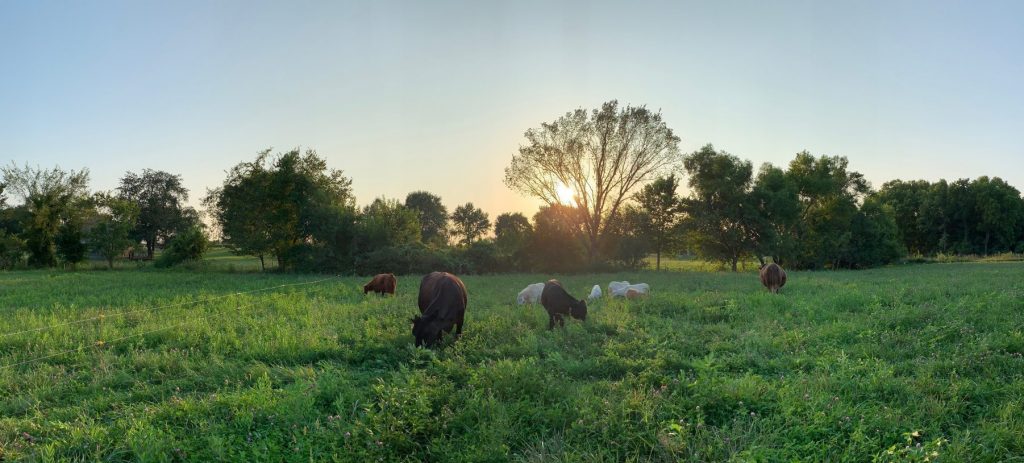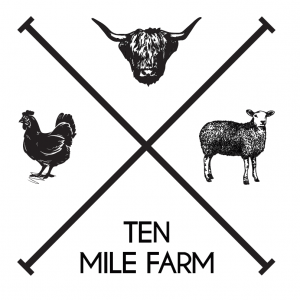
Grass-Fed & Grass-Finished Beef
We raise on our farm a combination of Scottish Highland and Angus Cross cows. Scottish Highland cows are one of the oldest breeds of heritage cattle originating from Scotland. Aside from their shaggy hair and long horns they are also known for their hardiness, maternal abilities, reproductive efficiency, longevity, and docile temperament. Because of their thick coat they thrive in cold and wet climates and are excellent grazers on forages that other cattle would not typically eat and are the perfect match for our grass-finished system.
Scottish Highland beef is best known for its tenderness and full flavor. It has less fat and cholesterol than conventionally raised beef partly because the long, shaggy hair coat diminishes the need of the animal to store excess fat along the back. Cuts of meat from Highland cows are smaller than what is presented on the supermarket shelves due in part from their smaller frame.
For customers wanting larger cuts of meat our Angus cross cattle are the perfect fit. In addition to several genetic and husbandry advantages our Angus cross cattle provide the perfect meat quality and quantity you expect in your beef. The Angus breed is known for its fast growth rate and superior marbling ability. Increased marbling leads to more beef tenderness and flavor. Combine that with the increase in nutrient density from our pasture management practices and you get an eating experience and protein source that is second to none.
How We Feed Our Cattle
Our cows are raised as herbivores should be—on grass and on pasture. From birth to harvest our cows spend their entire lives outside on pasture consuming a rich and diverse diet of grasses, legumes, and forbs. Our pastures are never treated with any chemical fertilizers, pesticides, or herbicides—completely chemical free. The only supplement our cows receive throughout the year is a loose mineral that provides them with the necessary macro and micro nutrients that may be lacking from the soil.
During the winter months our cows are fed only hay. Some of that hay comes in the form of stockpiled forage, some as hay harvested here on our farm, and some as hay purchased from other local farms. Generally it takes approximately 24-36 months to raise a cow on our farm from birth to harvest weight following these principles versus the industry standard of 16-18 months using grain.
Many farmers will raise their cattle on pasture like we do but for the last 60-90 days they provide grain (typically genetically modified grain) to fatten up the animals. At no time do we offer our cattle any grain. A cow’s body is not optimized to consume grain but instead is designed to consume, ferment, and digest grass as it’s source of food and energy.
We occasionally acquire calves and young steers that had been fed grain at some point on other farms. We will not feed them any grains while on our farm nor will we market these cows as entirely grass fed. We also ensure the customer has full disclosure on the health and diet history of the animal they are purchasing.
Animal Husbandry
Our cows are never broad-spectrum treated with vaccinations, antibiotics or growth stimulants. With our firm commitment to animal welfare and husbandry we evaluate sickness and injuries on a case-by-case basis. In the off chance a cow needs treatment that animal is removed from our clean meats program. We believe following these practices produces grass-fed and grass-finished meat that is pure, clean, delicious, and nutrient dense.
Pasture Management
On our farm, we manage the soil and pastures using rotational grazing methods. In our effort to mimic nature the cows are grouped together in smaller paddocks as they graze. They are moved into a new paddock with fresh grass every two to three days and the cycle repeats all throughout the growing season. There are so many benefits to managing in this manner—increased recovery time for grasses, increased nutrient quality and diversity of the forages in the pasture, increased organic matter and water retention capabilities of the soil, increased drought resistance of the pasture, and lower internal parasite problems for cattle just to name a few.
Bulk Beef Details
Quarter Beef
- A quarter-beef yields approximately 75-100 lbs of packaged meat for your freezer.
- A $300 non-refundable deposit is required to reserve you share.
- We provide transport of your animal to the butcher. You are responsible for collecting your meat from the butcher once it is ready for pickup.
- The customer is responsible for payment of the beef to our farm and payment to the butcher. Your final invoice from our farm will be sent after hanging weights are collected.
- We understand buying meat in this way can be intimidating so we are happy to educate and assist you throughout the entire butchering process. From discussing cut selection to calling in your cut sheet we are here to help!
- Every animal is unique and orders can differ significantly depending on customer cut selections. We make every effort to provide close estimates however prices may be higher or lower depending on the size of the animal and butchering instructions.
- These estimates are based on 1000 lb live weight cow. Depending on growth rate and other environmental factors the cows can weigh as much as 1200 lbs or more which would affect your final price and yield estimates.
Half Beef
- A half beef yields approximately 150-200 lbs of packaged meat for your freezer.
- A $450 non-refundable deposit is required to reserve you share.
- We provide transport of your animal to the butcher. You are responsible for collecting your meat from the butcher once it is ready for pickup.
- The customer is responsible for payment of the beef to our farm and payment to the butcher. Final invoices will be sent out after hanging weights are collected.
- We understand buying meat in this way can be intimidating so we are happy to educate and assist you throughout the entire butchering process. From discussing cut selection to calling in your cut sheet we are here to help!
- Every animal is unique and orders can differ significantly depending on customer selections. We make every effort to provide close estimates however prices can differ depending on the size of the animal and butchering instructions.
- These estimates are based on 1000 lb live weight cow. Depending on growth rate and other environmental factors the cows can weigh as much as 1200 lbs or more which would affect your final price and yield estimates.
Yield
Because every animal is unique and never produces the same yields each time you can expect some variations on what comes back from the butcher. However, a typical quarter beef can yield the following cuts:
- 25-35 lbs of Ground Beef
- 10-12 lbs of Chuck and Arm roasts
- 3-5 lbs of Rump roasts
- 3-5 lbs of Sirloin roasts
- 3-5 lbs of Minute steak or Stew meat
- 3-5 lbs of Ribeye steaks
- 3-5 lbs of New York strip steaks
- 3-5 lbs of Sirloin steaks
- 3-5 lbs of Fillets
- 2 lbs Skirt Steak
- 1-3 lbs of Flat Iron Steaks
- 1-3 lbs of Tri-Tip Steak
- 3-5 lbs of Brisket
- 2-4 lbs of Short Ribs
- 3-5 lbs of Soup Bones with meat
- 10-12 lbs of Bones for broth
- 3-5 lbs of Offal (liver, heart, oxtail, tongue)
Simply double these estimates for your half beef (side) estimates.


